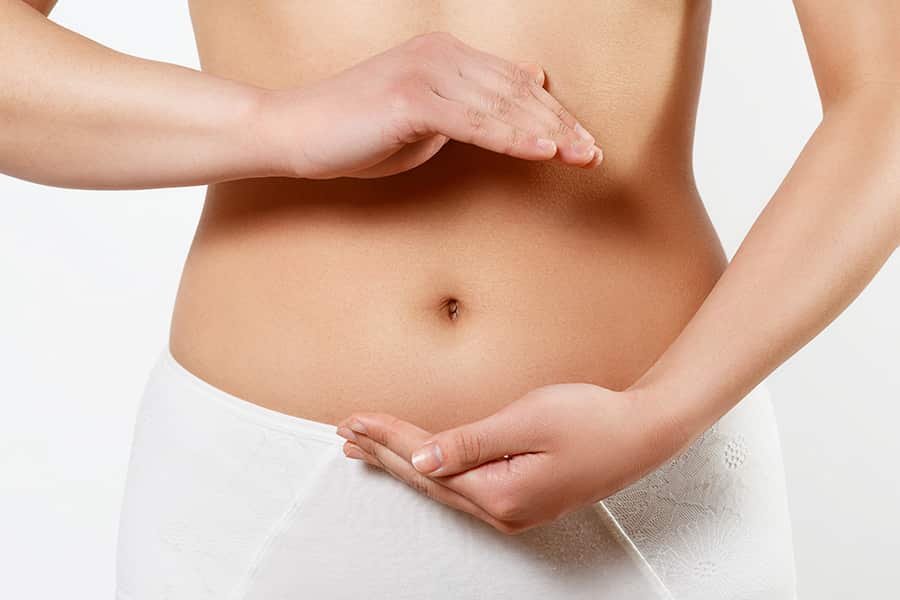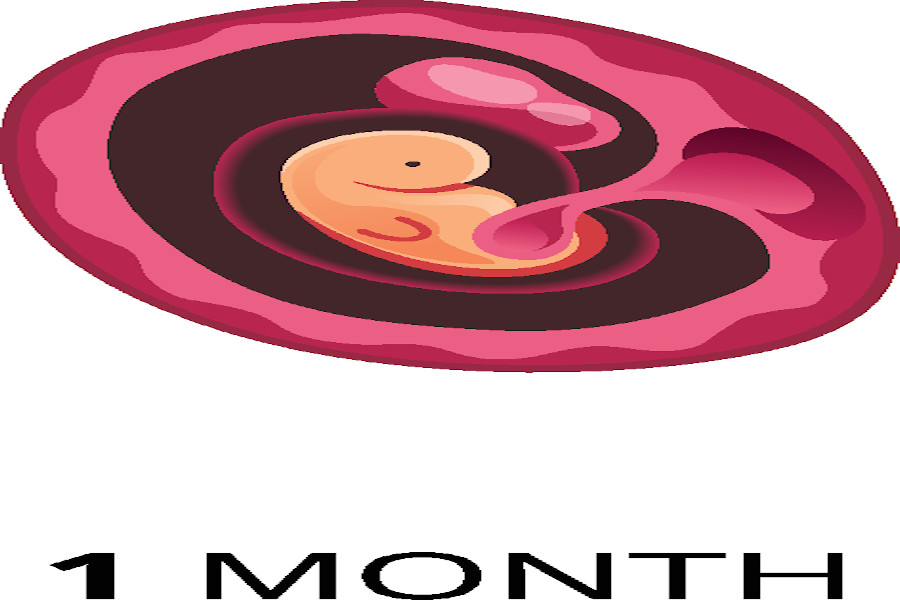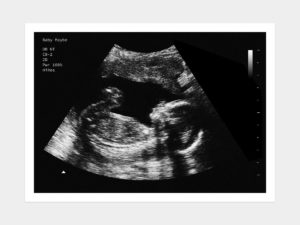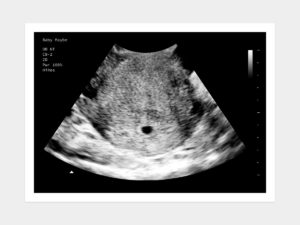
Pregnancy and fetal development have characteristic and predictable stages that can be seen or not seen, felt or not felt, and understood or not understood. After fertilization the embryo quickly begins to grow, change, and show characteristic signs and stages of human development. During the 40 weeks of gestation a single cell develops into an embryo consisting of thousands of cells and culminating in the delivery of a fully formed infant. Here are presented the changes seen in embryonic development from conception to the end of the first trimester.

You have ovulated and as the egg travels through the fallopian tube it encounters thousands of recently deposited sperm cells. It only takes one. Over the next 20 hours or so the egg’s nucleus combines with the sperm’s nucleus and their genetic material is now combined. You are now pregnant! The baby’s sex is now determined. The fertilized egg is called a zygote and after about 3 or 4 days it is called a blastocyst and has begun to burrow into the uterine wall.
The blastocyst is developing into a larger ball consisting of several hundred cells. The inner cells will become the embryo and the outer cells will become the placenta. The blastocyst receives oxygen and nutrients through a primitive system of tiny tunnels running between it and uterine blood vessels.
The embryo’s cells are rapidly dividing and developing. A primitive placenta is forming so your blood, which carries oxygen and nutrients, can reach the developing embryo to nourish it. The amnionic sac contains amnionic fluid which serves to enclose and cushion the developing embryo as it develops. A yolk sac will form which will produce your baby’s first red blood cells.

At this stage the embryo looks more like a tadpole than a human baby. This is NORMAL!! The neural tube or primitive nervous system is developing. This will give rise to the brain, spinal cord, and nerves. The heart and circulatory system are beginning to form. The placenta and umbilical cord are now more developed and functioning.
Your baby’s heart is beating! Your baby’s eyes and nostrils are starting to form. The first signs of the baby’s arms and legs look like little paddles.
The baby’s cornea, iris, pupil, lens, and retina start developing. The stomach and esophagus and liver start to develop this week. Your baby’s brain is quickly forming sitting atop the developing spinal cord.
Your baby starts to move! These movements are described as twitches or stretches and are visible on ultrasound. You won’t feel the movement, don’t worry. You will feel movement later in the pregnancy when the fetus is much larger at about 18 - 20 weeks gestation. The hands and feet have webbed fingers and toes. Nerves are spreading throughout the body connecting to muscles, organs, and other body structures.

The baby’s heart will now have 4 chambers like a fully formed heart and the familiar “lub-dub” sound can be heard during prenatal visits. Teeth buds are forming, and the placenta is more developed and able to perform all its functions. The digestive tract and reproductive organs are formed.
Eyelids cover the eyes. Teeth start to harden. Facial features are more distinct. The umbilical cord is formed and starting to perform its function of delivering oxygen and nutrients to the fetus. The brain continues to grow, and the fetal head is about half the length of the fetus’ body.
All vital organs are in place and may be functioning. External genitals are showing signs of development.
Fingers will open and close, toes curl, and the mouth will make sucking movements. The intestines are growing and will move into their permanent place inside the abdominal cavity. A thin layer of hair begins to grow on the body. Fingernails, toenails, and bones are forming.
Vocal cords start to develop. We know sex is determined at conception; at this stage of development external sex organs become more visible on an ultrasound.
The information is presented to be a general guide to present the events surrounding fetal development. It is for informational purposes only. The information provided is not intended to be the only information available concerning fetal development during the first trimester. The material provided is not expected to be a substitute for advice or information from your physician or health care provider.
If you have any questions, concerns, apprehensions, unease, or worry about your fetus’ development contact your health care provider immediately.








ALL WARRANTIES OF ANY KIND WHATSOEVER EXPRESS, IMPLIED, AND STATUTORY, ARE HEREBY DISCLAIMED. ALL IMPLIED WARRANTIES OF MERCHANTABILITY AND FITNESS FOR A PARTICULAR PURPOSE ARE HEREBY DISCLAIMED. THE PRODUCTS SOLD, INCLUDING SONOGRAMS, ULTRASOUNDS, FAKE PREGNANCY DOCUMENTS, AND FAKE PREGNANCY TESTS ARE SOLD ‘AS IS’ BASIS.
THE SITE CANNOT AND DOES NOT CONTAIN [MEDICAL/ LEGAL/ FITNESS/ HEALTH/ OTHER] ADVICE. THE INFORMATION IS PROVIDED FOR PRANKS PURPOSES ONLY AND IS NOT A SUBSTITUTE FOR PROFESSIONAL ADVICE.
ACCORDINGLY, BEFORE TAKING ANY ACTIONS BASED UPON SUCH INFORMATION, WE ENCOURAGE YOU TO CONSULT WITH THE APPROPRIATE PROFESSIONALS. WE DO NOT PROVIDE ANY KIND OF MEDICAL/ LEGAL/ FITNESS/ HEALTH ADVICE. THE USE OR RELIANCE OF ANY INFORMATION CONTAINED ON THIS SITE, OR OUR MOBILE APPLICATION, IS SOLELY AT YOUR OWN RISK.
THIS WEBSITE DOES NOT PROVIDE MEDICAL ADVICE. THE INFORMATION, INCLUDING BUT NOT LIMITED TO, TEXT, GRAPHICS, IMAGES AND OTHER MATERIAL CONTAINED ON THIS WEBSITE ARE FOR PRANK PURPOSES ONLY. NO MATERIAL ON THIS SITE IS INTENDED TO BE A SUBSTITUTE FOR PROFESSIONAL MEDICAL ADVICE, DIAGNOSIS OR TREATMENT. ALWAYS SEEK THE ADVICE OF YOUR PHYSICIAN OR OTHER QUALIFIED HEALTH CARE PROVIDER WITH ANY QUESTIONS YOU MAY HAVE REGARDING A MEDICAL CONDITION OR TREATMENT AND BEFORE UNDERTAKING NEW HEALTH CARE REGIMEN, AND NEVER DISREGARD PROFESSIONAL MEDICAL ADVICE OR DELAY IN SEEKING IT BECAUSE OF SOMETHING YOU HAVE READ ON THIS WEBSITE.
THE PARTIES AGREE THAT ANY PRODUCT PURCHASED ON THE BABY MAYBE WEBSITE SHALL NOT BE USED FOR ANY PROPOSE OTHER THAN AS A PRANK. WITHOUT EXCEPTION NO BABY MAYBE PRODUCT SHALL BE PROVIDED/SUBMITTED TO ANY GOVERNMENTAL OR OTHER AGENCY, MEDICAL DOCTOR, ARBITER OF A DISPUTE, AS PROOF OF PREGNANCY, PAST OR CURRENT, OR TO CLAIM ANY BENEFIT FOR WHICH A PREGNANT WOMAN MAY BE ELIGIBLE, OR ENTITLED TO RECEIVE, BASED ON HER BEING PREGNANT. NO HIPAA PROTECTED PATIENT HEALTH INFORMATION CONNECTED TO ANY BABY MAYBE PRODUCT, IS INTENDED, OR CONVEYED, WITH RESPECT TO THIS SALE.
THE PARTIES AGREE THAT BABYMAYBE IS NOT RESPONSIBLE FOR ANY LIABILITY WHATSOEVER FOR DELAYS IN SHIPPING THE PRODUCT. THE PARTIES FURTHER AGREE THAT THE SOLE REMEDY FOR ANY SHIPPING DELAYS IS THE REFUND OF THE PURCHASER’S PAYMENT FOR THE PRODUCT.
THE PARTIES AGREE THAT THE FORUM FOR ANY LEGAL ACTION ASSOCIATED WITH THE SALE AND PURCHASE OF THE PRODUCT IS THE STATE OF ILLINOIS.